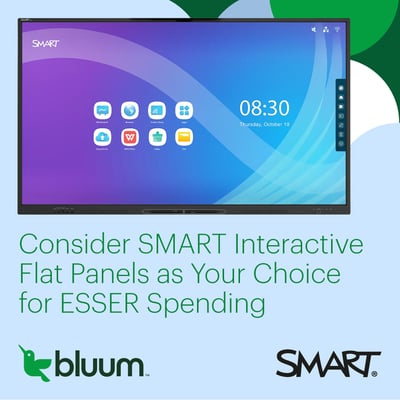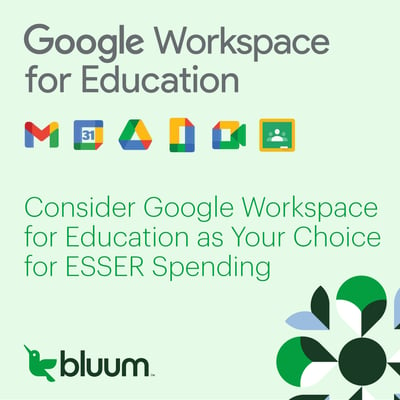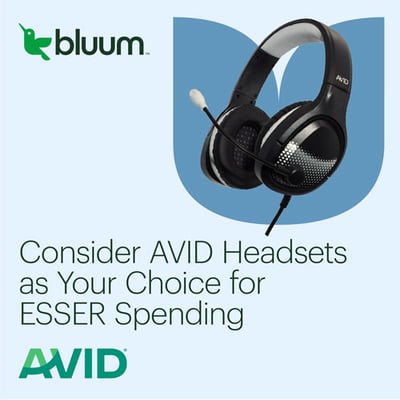As a category manager at Bluum, I get a first look at all of the latest and greatest Edtech to hit the market, with an opportunity to evaluate how each fits into the broader tech ecosystem of a classroom. What I’ve noticed is that in an era characterized by rapid technological advancement and evolving teaching approaches, the traditional “sage on the stage” classroom has given way to a new realm of learning possibilities. As we embrace the digital age, educators, students, and school leaders are tasked with redefining the essential components that foster effective and engaging learning experiences.
In this blog, I reflect on the core Edtech components that contribute to a modern classroom, and discuss how they shape this new educational landscape. And, as districts face the expiration of ESSER III funds, I share some of my favorite ESSER III allowable investments that you can make now to support a sustainable, engaging learning experience that improves learning and makes it more accessible for all.

1. Technology Integration: Enhancing Learning Horizons
Gone are the days when chalkboards and overhead projectors held power in classrooms. In today's modern learning environments, the integration of technology takes center stage. Interactive flat panels have revolutionized the way that students interact with content. These interactive displays empower educators to bring lessons to life, fostering active participation and understanding among students. I love seeing teachers use IFPs to do encourage collaboration among their students. One of my favorite tools is the SMART panel- their intuitive software like SMART Lumio, students are immersed in interactive lessons, game-based learning, and collaborative activities that stimulate critical thinking and adaptability. As a student, imagine the excitement of being able to co create content on a digital canvas with peers and then teach the class, just like the teacher. They can even create games to encourage student engagement in their lessons!
2. Flexibility and Adaptability: Meeting Diverse Needs
 Modern learning demands flexibility and adaptability to cater to diverse learning styles and circumstances. As students alternate between in-person classes and remote learning, educators must provide flexible tools and resources that bridge the gap. Software platforms like Google, which is accessible both in-class and at home, allow students to transition between learning environments, while still preserving the same learning content.
Modern learning demands flexibility and adaptability to cater to diverse learning styles and circumstances. As students alternate between in-person classes and remote learning, educators must provide flexible tools and resources that bridge the gap. Software platforms like Google, which is accessible both in-class and at home, allow students to transition between learning environments, while still preserving the same learning content. Additionally, recent reports have shown that students in special education make up a rising share of the student population, and the focus on differentiation for unique learning needs has become all the more critical. Adaptable tools ensure that students can engage with the material at their own pace and style, fostering a deeper understanding of the subject matter. For example, Chromebooks include accessibility features right out of the box. Built in settings and easy to use apps and extensions help customize the learning experience and engage students. Here are some examples:
- Display and vision: Increase content size, screen magnifier, reading mode
- Cognitive and spoken feedback: Select to speak, dictation, and note taking
- Audio and captions: Mono Audio and closed captions
- Motor and dexterity: onscreen keyboard, sticky keys, and touch input.
 AVID headphones are the perfect combination of quality and value. AVID headphones support various types of learners and learning environments. Not only do AVID headphones create a simplified and focused learning environment for personalized learning approaches, but also can provide support for language learning, reduce interruptions, support test preparation, and reduce stress through music amongst many other value applications.
AVID headphones are the perfect combination of quality and value. AVID headphones support various types of learners and learning environments. Not only do AVID headphones create a simplified and focused learning environment for personalized learning approaches, but also can provide support for language learning, reduce interruptions, support test preparation, and reduce stress through music amongst many other value applications.
3. Active Engagement: Fostering Participation and Critical Thinking
Engagement is the heartbeat of modern education. A successful learning environment encourages active participation, discussion, and critical thinking. The integration of gamified activities within promotes an atmosphere of excitement and curiosity. By transforming lessons into engaging experiences, educators ignite students' desire to explore, question, and analyze. Imagine learning about World History, when an Interactive Game Show about Ancient Greece pops up on the screen for a team competition, followed up with a discussion-based activity as a group-and it only takes the educator 5 minutes to create the activities!
4. Inclusivity and Safety: Nurturing a Supportive Environment
 A cornerstone of modern learning is the creation of an inclusive and safe environment for all students. Technology plays a pivotal role in this aspect, enabling educators to accommodate various learning needs and preferences. A supportive environment allows students to learn based on their level, whether this is through learning centers or whole group. When a teacher needs to target their interventions to small groups, I find it is incredibly helpful to have a tool like a mobile cart available. This allows teachers to easily move the technology they need for their lesson without any disruptions. Teachers can rearrange the physical learning space with minimal effort to ensure everyone's comfort and engagement.
A cornerstone of modern learning is the creation of an inclusive and safe environment for all students. Technology plays a pivotal role in this aspect, enabling educators to accommodate various learning needs and preferences. A supportive environment allows students to learn based on their level, whether this is through learning centers or whole group. When a teacher needs to target their interventions to small groups, I find it is incredibly helpful to have a tool like a mobile cart available. This allows teachers to easily move the technology they need for their lesson without any disruptions. Teachers can rearrange the physical learning space with minimal effort to ensure everyone's comfort and engagement.
5. Student-Centered Approach: Cultivating Lifelong Learners
Modern learning hinges on a shift from a teacher-centered to a student-centered approach- from “sage on the stage” to “guide on the side.” With technology as the enabler, educators can tailor instruction to individual strengths, interests, needs, and progress. Using real-world scenarios that are relevant and compelling to students, we are preparing our students for tomorrow’s world of work. Interactive and adaptive features facilitate personalized learning journeys while the technology creates a dynamic classroom setup that resonates with modern students' expectations. Instead of reading a textbook about XYZ, students can have an immersive experience to better engage with and internalize the learning content.
The essentials for modern learning transcend the confines of traditional education. We are no longer limited by geography, by learning style, or environment. By embracing technology, fostering flexibility, prioritizing engagement, nurturing inclusivity, and adopting a student-centered mindset, educators can craft learning experiences that prepare students for the challenges and opportunities of a rapidly evolving world.
As we navigate this dynamic educational landscape, understanding which of these essentials are ESSER III allowable uses will assist districts in providing the tools necessary to sustain a modern classroom.
Connect with Us
Connect with our Educational Services team to request a quote for a comprehensive ESSER audit & consultation, receive grant and funding guidance, or book a free 30-minute consultation with our Educational Strategist.



